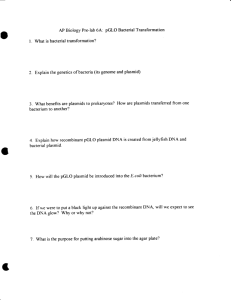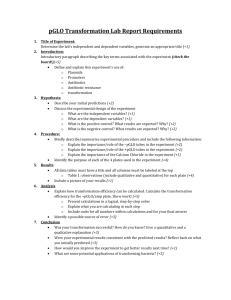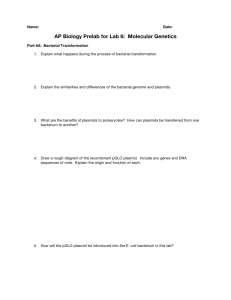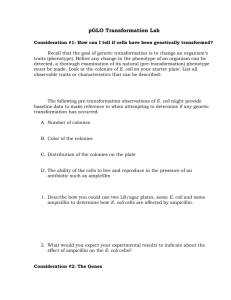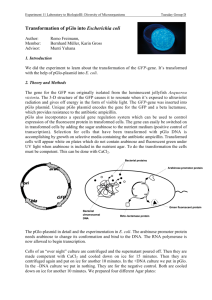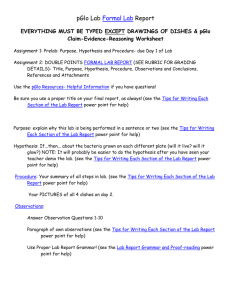pGLO lab report
advertisement
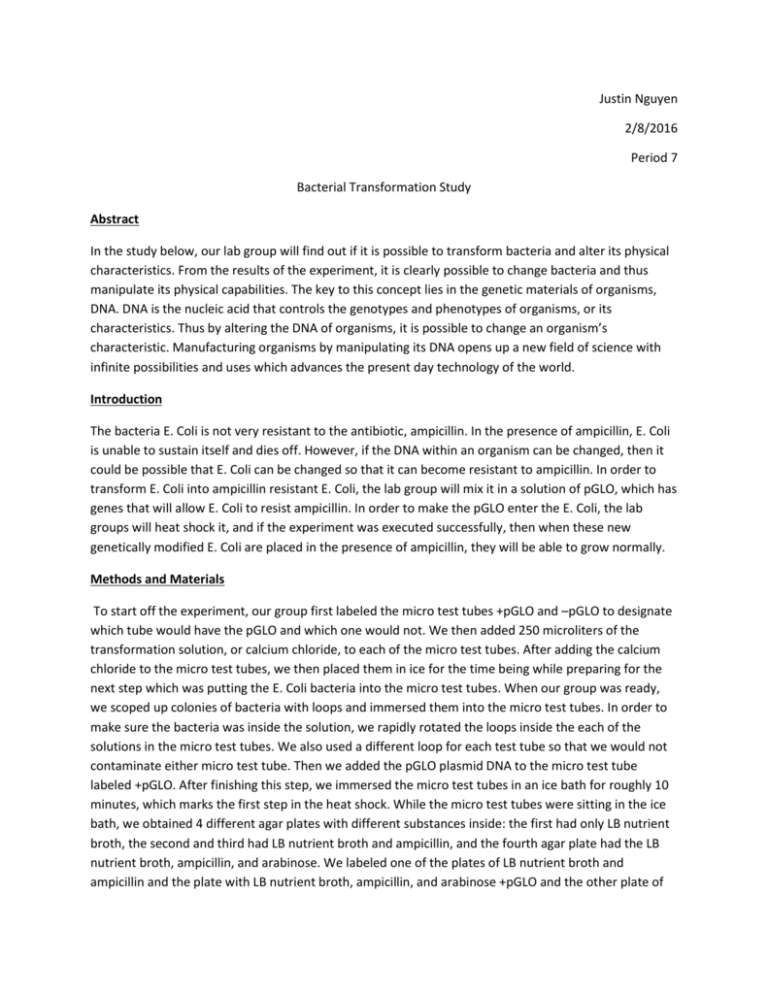
Justin Nguyen 2/8/2016 Period 7 Bacterial Transformation Study Abstract In the study below, our lab group will find out if it is possible to transform bacteria and alter its physical characteristics. From the results of the experiment, it is clearly possible to change bacteria and thus manipulate its physical capabilities. The key to this concept lies in the genetic materials of organisms, DNA. DNA is the nucleic acid that controls the genotypes and phenotypes of organisms, or its characteristics. Thus by altering the DNA of organisms, it is possible to change an organism’s characteristic. Manufacturing organisms by manipulating its DNA opens up a new field of science with infinite possibilities and uses which advances the present day technology of the world. Introduction The bacteria E. Coli is not very resistant to the antibiotic, ampicillin. In the presence of ampicillin, E. Coli is unable to sustain itself and dies off. However, if the DNA within an organism can be changed, then it could be possible that E. Coli can be changed so that it can become resistant to ampicillin. In order to transform E. Coli into ampicillin resistant E. Coli, the lab group will mix it in a solution of pGLO, which has genes that will allow E. Coli to resist ampicillin. In order to make the pGLO enter the E. Coli, the lab groups will heat shock it, and if the experiment was executed successfully, then when these new genetically modified E. Coli are placed in the presence of ampicillin, they will be able to grow normally. Methods and Materials To start off the experiment, our group first labeled the micro test tubes +pGLO and –pGLO to designate which tube would have the pGLO and which one would not. We then added 250 microliters of the transformation solution, or calcium chloride, to each of the micro test tubes. After adding the calcium chloride to the micro test tubes, we then placed them in ice for the time being while preparing for the next step which was putting the E. Coli bacteria into the micro test tubes. When our group was ready, we scoped up colonies of bacteria with loops and immersed them into the micro test tubes. In order to make sure the bacteria was inside the solution, we rapidly rotated the loops inside the each of the solutions in the micro test tubes. We also used a different loop for each test tube so that we would not contaminate either micro test tube. Then we added the pGLO plasmid DNA to the micro test tube labeled +pGLO. After finishing this step, we immersed the micro test tubes in an ice bath for roughly 10 minutes, which marks the first step in the heat shock. While the micro test tubes were sitting in the ice bath, we obtained 4 different agar plates with different substances inside: the first had only LB nutrient broth, the second and third had LB nutrient broth and ampicillin, and the fourth agar plate had the LB nutrient broth, ampicillin, and arabinose. We labeled one of the plates of LB nutrient broth and ampicillin and the plate with LB nutrient broth, ampicillin, and arabinose +pGLO and the other plate of LB nutrient broth with ampicillin and the plate with just LB nutrient broth –pGLO. Finally, when the 10 minutes were up for the micro test tubes in the ice bath, our lab group quickly move the micro test tubes to a tub of hot water at 42 degrees Celsius and let the tubes sit there for exactly 50 seconds. After those 50 seconds, we quickly moved the micro test tubes back into the ice bath and let it sit there for 2 more minutes, thus completing the heat shock. After the two minutes were up, we used droppers and placed 100 microliters of the +pGLO and –pGLO solutions in their respective ager plates which we had labeled earlier. Using 4 new and unused loops for each ager plate, we spread around the bacteria in the plate. Finally we put the lids on the 4 ager plates, and placed them in the incubation chamber overnight and revisited them the next day for analysis. Results When my lab group returned the next to observe the results of our experiment, we were fairly pleased with our results. Everything had gone to plan and there was nothing out of the ordinary. The unmodified E. Coli on the LB plate grew because there was nothing to prevent it from growing. The unmodified E. Coli on the LB/AMP plate died because ampicillin is an antibiotic that E. Coli is not resistant to. The modified E. Coli in the LB/AMP grew normally, which means that my group successfully transferred the pGLO plasmid DNA strand to the E. Coli, which then allowed E. Coli to resist ampicillin and grow. Lastly, the modified E. Coli in the LB/AMP/ARA plate grew in a similar way to the modified E. Coli in the LB/AMP plate because our group was successfully in transferring the pGLO plasmid DNA strand to the E. Coli allowing it to survive. However, the modified E. Coli in the LB/AMP/ARA plate glowed green under the presence of a UV, which further verifies that my group’s E. Coli transformation was successful because the bacteria will only glow in the presence of arabinose and must have a gene on the pGLO plasmid. All the characteristics of the bacteria in each ager plate are also tabulated below. One very particular thing I noticed when observing the three ager plates with the live bacteria was that the bacteria without pGLO was greasier and messier then the bacteria with the pGLO plasmid DNA. From this information, I believe that the pGLO plasmid DNA must have deactivated this specific characteristic of E. Coli as the modified E. Coli did not exhibit this specific trait. Overall as a class, our experiment was extremely success, with all groups successfully transforming E. Coli into a modified E. Coli with a pGLO plasmid DNA strand. Every group calculated its transformation efficiency and the numbers are all over the place, which means each group may or may not have messed up in some part of the experiment. According to scientists who have already done this experiment, the transformation of this experiment should be around 800 transformants per microgram of pGLO DNA, and 7000 transformants per microgram of pGLO DNA. When these numbers are compared to the different transformation efficiencies of the class, only two groups are consistent with the numbers of the scientist while the other three must have had some mishaps along the way during the experiment or miscalculations during the analysis part of the experiment. But despite this fact, the experiment overall was a success as all groups were able to get at least some transformed bacteria. Discussion and conclusions Going off from the table above, it is very clear that the transformation efficiency rates vary massively between all five groups, which brings up the question of what caused this enormous amount of discrepancy. I can speculate that the answer behind this question is the heat shock, which was a very crucial part of the experiment as it was the specific point where the pGLO plasmid DNA would enter the E. Coli bacteria, causing transformation to occur. During the heat shock portion of the experiment, really only one thing can go wrong, and that is the solution not directly absorbing or losing heat energy in the hot water tub or the ice bath. This can happen in a number of ways, including not simply pushing in the micro test tubes into the hot water bath or ice bath but that is not plausible as it is a very simple step. I believe that the error comes with working such little amounts of pGLO and adhesion. I noticed that as my lab member dropped in tiny increments of solutions into the micro test tubes, some of the solution would stick onto the walls. Luckily, I caught this and instructed my group member to stir the tube and push down the liquid with a loop. So to explain the relatively small transformation efficiencies of some the groups above, I believe it came from not stirring up the solution well enough before the heat shock and since the experiment was working with tiny amounts of various substances, every little bit matters. After all the analysis in this paper, there is a clear victor in terms of which group executed the experiment accurately. And it will have to go to the juniors, with a transformation efficiency of 5535.7 transformants per microgram of pGLO. Although this transformation is not the highest, it is the high efficiency rating that falls within the scientist’s determined value which was between 800 transformants to 7000 transformants. And this means, Mr. Wong was indeed correct; the best group in this experiment was his juniors. References Student Manuel pGLO Transformation
